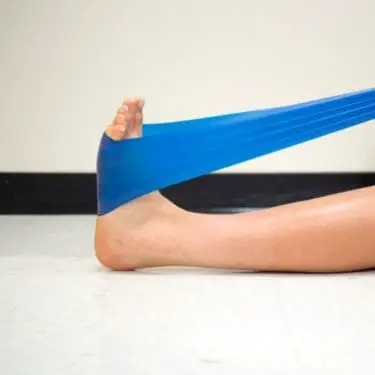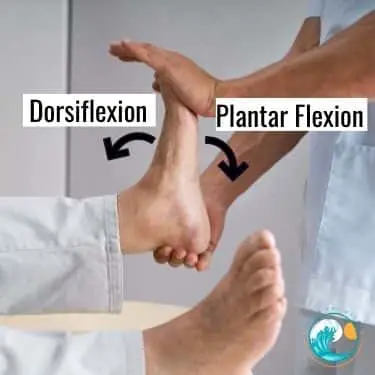Many people don’t think about the importance of ankle flexibility for swimming, but it can make a big difference to your swim speed.
Studies have found that most of the propulsive force (and therefore speed) generated while swimming the dolphin kick comes from the feet, specifically between the top of the ankle to the toes. This force is estimated to be as much as 90%, highlighting ankle flexibility as essential for swim speed.
This statistic blew my mind when I first read it in this article. [source]
“90 percent of the thrust in a dolphin kick comes from the ankles and feet”
https://www.iol.co.za/ios/behindthenews/the-science-behind-swimming-1347947
The dolphin kick involves using some of the biggest muscles in our body and to think that it is the tiny ankles that are contributing most to the force!
As the dolphin kick is one of the most powerful swim kicks and coupled with the fact that swimming underwater is faster, I am beginning to see why ankle flexibility could be the secret to swimming faster.
The best swimmers in the world have amazing dolphin kick technique and if all the studies are to be believed, it suggests that all top swimmers have excellent ankle flexibility.
In this article, I want to dig deeper into the published research papers and studies on this topic to understand just how important ankle flexibility is for swimming faster and how I can improve my ankle flexibility, including:
- Is ankle flexibility important for swimming? [What the research says]
- How do you know if you have flexible ankles?
- What causes poor ankle flexibility?
- How to improve ankle flexibility for swimming

Is Ankle Flexibility Important For Swimming?
Ankle flexibility is extremely important for swimming as it allows you to generate more force with your feet, which helps you to swim faster. When you’re able to move your ankle and foot up and down easily, you’re able to create more propulsion with each kick.
This is why many of the top swimmers in the world have amazing ankle flexibility.
If you’re looking to improve your swimming speed, focus on improving your ankle flexibility and dolphin kick technique.
Studies have shown that ankle flexibility is a component of kicking efficiency, but what exactly do some of these studies conclude?
Here is a brief summary of some of my favourite research that has been done in this area.
I have done my best to distil this info to make it concise as these are complex academic studies, but I have linked to each of these academic papers so you can dig deeper if you want to geek out on this info.
| Study Title | Study Overview | Ankle Flexibility Summary |
|---|---|---|
| “A computational method for analysis of underwater dolphin kick hydrodynamics in human swimming” Citation Alfred Von Loebbecke, Rajat Mittal, Russell Mark & James Hahn (2009) A computational method for analysis of underwater dolphin kick hydrodynamics in human swimming, Sports Biomechanics, 8:1, 60-77, DOI: 10.1080/14763140802629982 | This study uses new simulation methods, including the use of laser body scans and underwater video footage, to simulate the dolphin kick. | It is found that most of the thrust is produced by the feet and in both cases, the down-kick produces a much larger thrust than the up-kick. |
| “Does ankle joint flexibility affect underwater kicking efficiency and three-dimensional kinematics?“ Citation Hirofumi Shimojo, Rio Nara, Yasuhiro Baba, Hiroshi Ichikawa, Yusuke Ikeda & Yoshimitsu Shimoyama (2019) Does ankle joint flexibility affect underwater kicking efficiency and three-dimensional kinematics?, Journal of Sports Sciences, 37:20, 2339-2346, DOI: 10.1080/02640414.2019.1633157 | Physical experiments were completed on swimmers to investigate the propelling efficiency. | It is found that underwater swimming velocity is affected by the mobility of the feet. |
| “The effect of ankle muscle strength and flexibility on dolphin kick performance in competitive swimmers” Citation Willems TM, Cornelis JA, De Deurwaerder LE, Roelandt F, De Mits S. The effect of ankle muscle strength and flexibility on dolphin kick performance in competitive swimmers. Hum Mov Sci. 2014 Aug;36:167-76. doi: 10.1016/j.humov.2014.05.004. Epub 2014 Jun 28. PMID: 24984154. | Ankle range of motion (ROM) and ankle muscle strength were measured in 26 healthy, competitive swimmers. | The results suggest that dolphin kick velocity might be enhanced by ankle muscle strength exercises and that subjects with restricted ankle flexibility might profit from a flexibility program. |
These academic studies have been done by top researchers and this information is a gold mine for swimmers, from elite pros to the average recreational swimmer.
Ankle flexibility is important to swimming efficiency and, as a result, swim speeds.
How Do You Know If You Have Flexible Ankles?
Since it is widely accepted that flexible ankles are a key component of swimming faster, how do you know if you have flexible ankles?
Before trying to improve your ankle flexibility, it can be a good idea to assess what level of flexibility you currently have.
From this measured benchmark, you can gauge how well you are progressing and improving your ankle flexibility.
How Do You Measure Ankle Flexibility?
The range of motion of the ankle (or direction of motion) is described in terms of dorsiflexion and plantar flexion.
Dorsiflexion is moving your foot towards your shins, and plantar flexion is moving your foot away from your shin. [source]
Below is an image showing what direction dorsiflexion and plantar flexion are.

As a general rule, a range of ankle motion (dorsiflexion) should be between 10 and 20 degrees for most people. For athletes, ankle mobility should be higher with a dorsiflexion range of between 20 and 30 degrees of motion.
Unless you have a protractor, which is a measurement device that can help measure angles, this can be hard to work out. However, I have found the following simple ankle mobility test that can help you establish how flexible your ankles are.
In addition, this excellent video gives you a target so you know if you are improving your ankle flexibility.
I have started doing the above exercise, trying to get my foot five inches from the wall as described in the video.
To keep track of my ankle flexibility improvements, I have put a piece of tape on the ground to mark where my feet currently are.
Over time, I hope to improve my ankle flexibility and by seeing my improvements; I hope it will motivate me to keep working on this.
What Causes Poor Ankle Flexibility?
Having poor flexibility in my own ankles, I am eager to work out what causes poor ankle flexibility.
Here are some of the most common causes of poor ankle flexibility according to Medical News Today:
- Poor flexibility in the calf and lower leg.
- Lack of use.
- Previous injury.
- Genetics.
- Scar tissue in the joint.
I played a lot of field sports as a child and have sprained my ankles so many times I have lost count.
As a result, I spent most of my youth sporting days with a brace on my ankles.
Today, I have terrible flexibility in my ankles, and it is affecting my swimming. Perhaps all those years of ankle injury without proper treatment have caught up with me?
The good news is that ankle mobility and flexibility can be improved through ankle exercises and stretching. [source]
If you are a swimmer and want to ankle flexibility to help your speed and swim efficiency, it can be done.
How To Improve Ankle Flexibility For Swimming
There are many exercises online that can help improve your ankle flexibility and start getting more power from your swim kicks.
It can be daunting at first to know where to start, as there is so much information and videos online.
As my ankles are very precious to me, so I am going to stick to taking my health and exercise advice from a good authority medical site such as Healthline.
The button below will take you to an article from Healthline that shows 12 Stretch and Strength Moves for Ankle Mobility. This is one of the best and easiest resources I have found for ankle mobility exercises.
What I really like about the following advice from Healthline is that they describe how to do the exercise with a video.
Most of the exercises detailed by Healthline can be done with no fancy equipment.
If you are wondering what the minimal equipment shown in the exercises is, here is a link to these exercise products on Amazon:
To be honest, the only piece of exercise equipment that I have found useful while trying to improve my ankle flexibility are the stretch bands.
If you want to learn more about stretch bands or stretch cords and how you can use them to improve your swimming on dry land, check out this article which covers the topic in greater detail: Stretch Cord Exercises For Swimmers – Improve On Dryland
Final Thoughts
I feel that good ankle flexibility is one of the best-kept secrets to swimming faster.
Unless you are a child swimmer who grew up with all the training or perhaps seriously into your swimming as an adult, it is unlikely that you will stumble across this information.
From all my adult swimming lessons classes, not one teacher ever spoke to me about ankle flexibility and how important it is for propulsion.
As someone who loves to swim and who wants to get faster, I believe that improving my ankle flexibility could unlock another level of swim speed potential.
If you are looking to improve your ankle flexibility too, there are many exercises that you can do with no fancy equipment.
Healthline provides a great resource of 12 Stretch and Strength Moves for Ankle Mobility. The exercises detailed by Healthline can be done with no special equipment, just stretch bands which I have found to be the most useful.
With consistency, you will improve your ankle flexibility and, if the academic studies are to be believed, see an improvement in your swim times.
Happy swimming!
